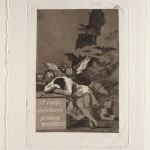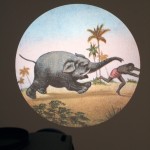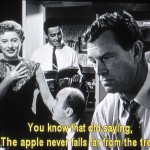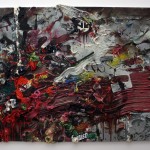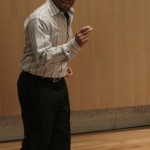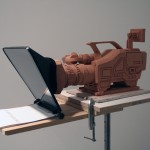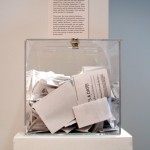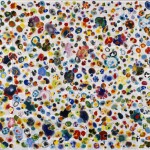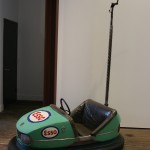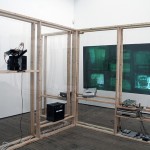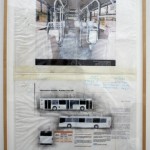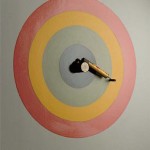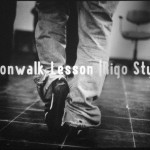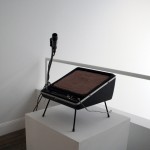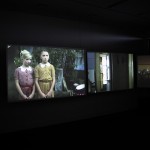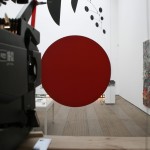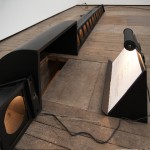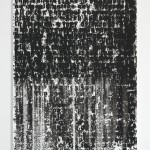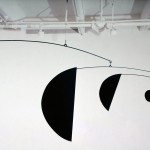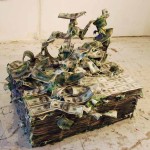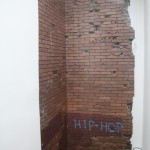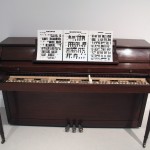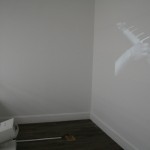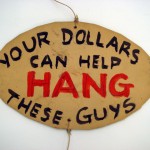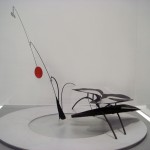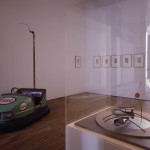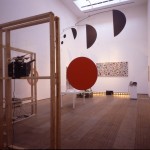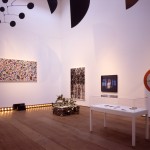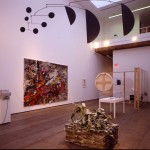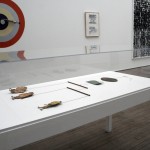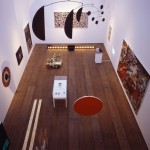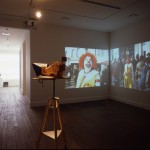Curated by Sandra Antelo-Suarez, TRANS>
New York, March 20, 2008
Hello My Dear Sandy,
It has been too long since we saw each other last. But now I am writing to make a date with you. It is going to be you and me.We are doing a get together, as they say in New Hampshire. Francisco will be sharing with us his Caprichos. Sandy is preparing his trip to Paris with his circus, but he has something political and sublime for the space. I haven’t told you, have I?
We leased a new space with a Romeo & Juliet balcony for declarations and declamations. Yes, after all it is election year…. So I happen to be choosing.
Glenn stopped by and will be lending a mirror, now. Karin, of course, will be doing her partitions and situations… that always means more people. Mario went on an expedition to Greece …Dave will dance with you; Paul is providing the stage lights and; Tim is doing his collaboration with KOS and Henry Street Settlement; Fabian has effervescent dollars….(Rumor has it that a group of your social conceptualist friends will be here to greet you)
But let’s catch up here; there is so much I need to talk with you. Fill you in.
Let me know when you can come. Or don’t; just come any time. We will be here. Our space is always here, for you and I.
Anyhow, I can’t tell you how honored (or intensified, or black and blue, or shocked and awed, or rarified) we would be with your presence.
Un abrazo,
Sandra
Participating Artists
Glenn Ligon, Mario Garcia Torres, Dave McKenzie, Minerva Cuevas, Tim Rollins + K.O.S., Fabian Marcaccio, Pawel Althamer, Sejla Kameric, Karin Schneider, Allan Kaprow, Olivier Mosset, Francisco de Goya, Paul Ramirez-Jonas, Alexander Calder, Jose Iraola, Jorge Luis Borges, Joseph Beuys, Dan Graham, Darcy Lange, Claudio Perna, Elka Krajewska, Anthony McCall, Bunita Marcus, and Freda Salvaje.
You & Me, Sometimes…
Curated by Sandra Antelo-Suarez, TRANS>
Exhibition Dates: March 20 – May 3, 2008
Reception: Sunday, March 30, Noon – 6 pm
Gallery hours: Tuesday – Saturday, 10 – 6 pm
Announced Scenes Schedule
March 20, 8- 9 pm back stage visit
March 22, 10 am curtains open
March 22, 2 – 6 pm Tim Rollins & K.O.S. finish A Midsummer Night’s Dream (after Shakespeare and Mendelssohn) with the Henry Street Settlement kids.
March 30, 3 pm Fresa Salvaja
April 12, 6 pm BOUND, A projected walk-through by Elka Krajewska with lightscore by Anthony McCall, sound score by Bunita Marcus. Expected duration:15 minutes
April 22, 7 pm Sandra Antelo-Suarez introduces his friend Dan Graham
Dan Graham and Laurie Zippe introduce the work of Darcy Lange
7:30 pm Darcy Lange Film Screening
April 25, 4 pm Donald McRonald bv Minerva Cuevas. Location: Union Square Mc Donald
May 3, 12 – 6pm Private Dancer by Dave McKenzie
Unexpected scenes will be taken place at any time, stop by.
Sponsorship
You & ME, Sometimes… has received support from the Bronx Museum; AV workshop; Soho Grand Hotels; Americas Society; Mexican Institute, NY; and Princeton Library; and New York Public Library.
Special thanks to
Terry, Jennifer and Sandy at the Calder Foundation; Judith Dolkart and Deana Setzke at the Brooklyn Museum, the lenders to the exhibition that with much kind and care have lent artworks. Manuela Arnal brought research, detail, sense of humor and much needed support to this exhibition. Matt Castle for his care installing the Calders. Jan Endlich, Corrina Bouthilette, Christine Krol, Stephen Brodheim, Joe Palumbo, Virgil Polit, Wyatt Kahn, Courtney Plummer, Kristina Schönberg, and Stephanie Smith worked double at Lehmann Maupin with 2 new spaces and this project. Rachel and David for providing the vision and trust. Lili Chin did this video, thank you. Last but not least, the participating artists have been extremely generous and involved in the process of this project, thank you for providing the fun, ideas and work. It has been 6 weeks of fun work for me.
Thank you to my baby… Jorge Alejandro that inspires me in every gesture he makes.
Lenders to You & Me, Sometimes…
Brooklyn Museum, Brooklyn; Calder Foundation, New York; Jose Iraola, Miami; Minerva Cuevas & Kurimanzutto; Marjory Jacobson Collection, Boston; Rodney Miller Collection, New York; Mario Garcia Torres & Jan Mot; Sejla Kameric; Dave McKenzie; Fabian Marcaccio ;Olivier Mosset; Paul Ramirez-Jonas; Tim Rollins + K.O.S.; and Karin Schneider.
[pdf-embedder url=”http://transmag.org/wp-content/uploads/2020/09/U-Me-newspapers.pdf” title=”U & Me newspapers”]
GLENN LIGON (b. 1960) is an artist living and working in New York. Through his work he pursues an incisive exploration of American history, literature, and society across a body of work that builds critically on the legacies of modern painting and more recent conceptual art. He is best known for his text-based paintings, made since the late 1980s, which draw on the writings and speech of diverse figures including Jean Genet, Zora Neale Hurston, Gertrude Stein and Richard Pryor.
He received a Bachelor of Arts from Wesleyan University and attended the Whitney Museum Independent Study Program.
In 2011 the Whitney Museum of American Art held a mid-career retrospective of Ligon’s work, Glenn Ligon: America, organized by Scott Rothkopf, that traveled nationally. Important recent shows include Glenn Ligon: Encounters and Collisions (2015), a curatorial project organized with Nottingham Contemporary and Tate Liverpool, and Blue Black (2017), an exhibition Ligon curated at the Pulitzer Arts Foundation in St. Louis, inspired by the site-specific Ellsworth Kelly wall.
Ligon has also been the subject of solo museum exhibitions at the Camden Arts Centre in London, the Power Plant in Toronto, the Walker Art Center in Minneapolis, and the Studio Museum in Harlem, among others. His work has been included in major international exhibitions, including the Venice Biennale (2015 and 1997), Berlin Biennal (2014), Istanbul Biennal (2011), Documenta XI (2002), and Gwangju Biennale (2000).
MARIO GARCIA TORRES (born 1975 in Monclova, México) is one of the most internationally renowned Latin American artists.
He has used various media, including film, sound, performance, ‘museographic installations’ and video as a means to create his art. Garcia Torres often mentioned untold or ‘minor’ histories, with a predilection for avant-garde art and music from the 1960s and 70s, as departing points for his work. He has re-created historical exhibitions and has even ‘completed’ unfinished artworks, often blurring original and reenactment, past and present, while questioning universal ideas about truth, certainty and time –all core ideas in the development of his body of work. During the early 2000s García Torres stopped dating his works; In so doing, he undermines the narrative of an oeuvre and career as a progressive evolution over time. n.d. (no date) often accompanies, since then, the work’s title, and has become a signature of the artist.
García Torres currently works in Mexico City and Los Angeles.
DAVE MCKENZIE is a visual and performance artist born in Kingston, Jamaica.
Recent solo exhibitions include “Dave McKenzie: Everything’s Alright, Nothing’s Okay!” at the Rosenwald-Wolf Gallery at the University of the Arts, Philadelphia, PA; “Dave McKenzie,” at the Aspen Art Museum in Aspen, Colorado; “Screen Doors on Submarines,” REDCAT, Los Angeles; and “Momentum 8: Dave McKenzie,” The Institute of Contemporary Art, Boston. McKenzie’s work was included in “Etched in Collective History,” at the Birmingham Museum of Art, Birmingham, AL; “Radical Presence: Black Performance in Contemporary Art,” at the Contemporary Arts Museum Houston, Houston, TX; “Prospect.1” New Orleans, LA; and in other group exhibitions at the RISD Museum, Providence, RI; the New Museum, New York, NY; the Indianapolis Museum of Art, Indianapolis, IN, in “The Studio Museum in Harlem, NY; The Kitchen, New York, NY; and at the Brooklyn Museum of Art, Brooklyn, NY.[1] He received a Foundation for Contemporary Arts Grants to Artists award (2018).
MINERVA CUEVAS was born in Mexico City in 1975. She’s a conceptual and socially-engaged artist who creates sculptural installations and paintings in response to politically-charged events, such as the tension between world starvation and capitalistic excess.
Cuevas documents community protests in a cartography of resistance while also creating mini-sabotages—altering grocery store bar codes and manufacturing student identity cards—as part of her non-profit Mejor Vida Corp / Better Life Corporation.
Several of the artist’s works take the form of re-branding campaigns—exhibited as murals and product designs—that question the role corporations play in food production, the management of natural resources, fair labor practices, and evolving forms of neo-colonialism.
Cuevas finds provocative ways to intervene in public space, whether through the deployment of billboards and posters, or by hacking public utilities to provide discounted or free services. Cuevas addresses the negative impact that humans have on animals and the environment through sculptures coated in tar and tender paintings of animal rights activists, imagining a society that values all living beings.
TIM ROLLINS + K.O.S. (b. 1955, Pittsfield, ME; d. 2017, New York, NY) began his career teaching art for special education middle school students in a South Bronx public school.
In 1984, he launched the Art and Knowledge Workshop, an after school program for his most dedicated students, who named themselves Kids of Survival (K.O.S.). While many of the original K.O.S. members are actively involved in the collaboration today, Rollins intended for flexibility within the group to allow for new generations of members. Rollins’ pedagogical technique of reading and discussing literary texts as the inspiration for his students’ artwork continues to be the basis on which the group makes their collaborative work.
Rollins and K.O.S. often paint and draw directly on the pages of books or sheet music that they adhere in a grid to the surface of the canvas. They have used numerous works as source materials, including literary classics by William Shakespeare, Dr. Martin Luther King Jr., Mark Twain, and musical compositions by Felix Mendelssohn and Richard Strauss.
For their 2013 show with Lehmann Maupin, the group exhibited Darkwater, using the pages of a 1920 first-edition copy of W.E.B. Dubois’ eponymous autobiographical collection of essays and short stories that confronted issues of race, class, and gender. Rollins and K.O.S. dipped 24 pages from the book in a solution of black watercolour paint, rendering the bottom half of every page illegible. The Darkwater series was made in collaboration with junior high school students in Savannah, Georgia, during a week-long workshop. Just as he had done with the original Kids of Survival, Rollins encouraged the students to engage with some of the very complex issues discussed in Dubois’ book through the process of art making, demonstrating the collective’s continued dedication to collaboration, social engagement, and education.
FABIAN MARCACCIO work investigates whether the traditional medium of painting can survive in the digital age.He has used printmaking and transfer techniques to make paintings and became well know in the 1990s for his sculptural manipulations of the two-dimensional surface of canvas.
More recently, he has infused his painting process with digital and industrial techniques. The results are environmental works, animations, and “Paintants” that combine digitally manipulated imagery, sculptural forms, and three dimensionally painted surfaces.
Fabian Marcaccio was born in Rosario, Argentina in 1963. He lives and works in New York City. He has exhibited widely throughout the United States, Europe and South America. Major solo exhibitions include “Paintant Stories” Casa Daros, Rio de Janeiro (2014), “Some USA Stories” Krefeld Kunstmuseen, Krefeld Germany (2012), “The Structural Canvas Paintants,” Lehmbruk Museum, Duisburg Germany (2012) and “From Altered Paintings to Paintants,” Kunstmuseum Liechtenstein, Vaduz, Liechtenstein (2004). Major group exhibitions include “Summer Projects,” PS1 Contemporary Art Center, New York (2002), Documenta 11, Kassel, Germany (2002) and the 44th Biennial of Contemporary American painting at the Corcoran Gallery of Art, Washington DC (1995). Works are in the collections of the Whitney Museum of Art, MOMA, Blanton Museum of Art, Miami Museum of Art (MAM), and the Museum für Moderne Kunst (MMK), among others.
PAWEL ALTHAMER born in 1967 in Warsaw, Paweł Althamer attended the Akademia Sztuk Pięknych, Warsaw (1988–93), earning a degree in sculpture. The artist is best known for groundbreaking projects involving community engagement, collaboration, and social transformation. They often incorporate sculpture and ultimately seek to reorient how art is made and displayed.
Althamer has had solo exhibitions at the Westfälischer Kunstverein, Munster, Germany (2002); Foksal Gallery Foundation, Warsaw (2004); Musée National d’Art Moderne, Centre Georges Pompidou, Paris (2006); Fondazione Nicola Trussardi, Milan (2007); Secession, Vienna (2009); and New Museum of Contemporary Art, New York (2014).
His work has been featured in several important group shows as well, including the Istanbul Biennial (2005); Berlin Biennial: Von Mäusen und Menschen/Of Mice and Men(2006); Skulptur Projekte Münster (2007); Gwangju Biennial, South Korea: Mainbo–10,000 Lives (2010); and Venice Biennale: Il Palazzo Enciclopedico/The Encyclopedic Palace (2013).
In 2004 he won the Vincent Award, hosted by the Bonnefantenmuseum, Maastricht, Netherlands.
He lives and works in Warsaw.
SEJLA KAMERIC was born in Sarajevo, Bosnia and Herzegovina. She has received widespread acclaim for her poignant intimacy and social commentary. Her work is included in European collections such as Musée d’Art Moderne de la ville de Paris; MACBA, Barcelona; Museum Boijmans Van Beuningen, Rotterdam; Museum of Contemporary Art, Zagreb; ERSTE Collection, Vienna; Deutsche Telekom, Bonn and Vehbi Koç Foundation, Istanbul.
Kamerić received The ECF Routes Princess Margriet Award for Cultural Diversity in 2011, and the DAAD-Berlin Artist Residency Fellowship in 2007.
Her first short film What do I Know, premiered in Corto Cortissimo section of (64th) Venice International Film Festival and circulated over 40 film festivals winning Golden Pram for the Best Short Film awards at (5th) Zagreb Film Festival and (15th) Adana Film Festival.
KARIN SCHNEIDER is a Brazil-born and New York-based artist, and filmmaker. In 1997, Schneider co-founded Union Gaucha Productions (UGP) an artist-run, experimental film company designed to carry out interdisciplinary collaborations with practitioners from different fields.
From 2005 to 2008, she was a founding member of Orchard, a cooperatively organized exhibition and social space in New York’s Lower East Side. From 2010 to 2014, Schneider co-founded Cage, a space that facilitated new kinds of social interactions.
Her current body of work, Situational Diagram, was the subject of a book and an exhibition at Dominique Lévy Gallery in 2016. Schneider’s diagrams explore the space of the exhibition reimagining it as a choreographical experience.
Her work was exhibited in several venues including the Museum of Modern Art, NYC; Artists Space, NYC; Sculpture Center, NYC; CAPC, Bordeaux; Museum of Art in Lodz, Poland; Museum of Modern Art, Rio de Janeiro; MCA, Chicago; Museum of Modern Art, Sāo Paulo; Barbican Center for the Arts, London; Museu Bispo de Rosario, Rio de Janeiro; Museo de Bellas Artes, Caracas; among others. Her work is in several collections such as Whitney Museum of American Art, Museum of Modern Art, São Paulo, Brazil; Museum of Modern Art, Rio de Janeiro, Brazil; Museum of Art in Lodz, Poland; Centre Georges Pompidou, Paris; Museum of Modern Art, Buenos Aires, Museum of Modern and Contemporary Art, Rijeka, Croatia among others.
ALLAN KAPROW (American, 1927–2006) was a performance artist and academic instructor known for his invention of the term Happening.
After showing an interest in drawing, Kaprow moved back to New York City where he began his education in the arts at the High School of Music and Art (now known as LaGuardia Arts). Kaprow received a BA at New York University in 1949 and an MA in Art History at Columbia University.
Before delving into a conceptual and philosophical approach to art, he created what he called “action collages”. During this time, Kaprow became more interested in the act and theatricality of painting and creating.
He began to produce sculptural installations he called Environments, which were assemblages of various sensory stimulants like light and sound; he ceased production after 1965. Apart from his work as a performance artist, Kaprow also studied musical composition under John Cage. He also spent a great deal of time teaching and lecturing at various institutes. In 1979, Kaprow received the John Simon Guggenheim Fellowship and the National Endowment for the Arts. His written works include his thesis Piet Mondrian: A Study of Seeing (1952), Assemblage, Environments, and Happenings (1966), and Essays on the Blurring of Art and Life (1993).
OLIVIER MOSSET in pursuit of formal rigor and the physical roots of painting, Olivier Mosset’s art is direct and self-evident, suppressing figuration, subjectivity, symbol, and metaphor in a practice that at once contains and rejects the dialectical history of painting. The 200 or more identical oil paintings that Mosset produced between 1966 and 1974, of a small black circle at the center of a square white canvas, are seen as the acme of BMPT’s experimental approaches to painting, which sought to challenge established methods of art-making and theorize a new social and political function for art and artists. Associated with conceptual abstraction, Mosset’s works represent pure color and shape, inciting open-ended physical experiences of surface, scale, and pattern.
Olivier Mosset was born in 1944 in Bern, Switzerland. Mosset’s work has been featured in several solo and group exhibitions. Recent solo museum exhibitions include Musée de Beaux-Arts La Chaux-de-Fonds, Switzerland (1985); Centre d’Art Contemporain, France (1985); “Olivier Mosset 65–85,” Musée Sainte-Croix, France (1985); Centre d’Art Contemporain, Geneva (1986); Musée Saint Pierre Art Contemporain, Lyon (1987); “Arbeiten/travaux/works 1966–2003,” Musée Cantonal des Beaux-Arts de Lausanne, Switzerland (2003); “Windows,” Palais de Tokyo, Paris (2006); Museo d’Arte di Mendrisio, Switzerland (2009); “A step backwards,” Musée d’art contemporain de Lyon, France (2010); “Leaving the Museum,” Kunsthalle Zürich, Switzerland (2012); “Sous apparence,” Opéra national de Paris, Palais Garnier, Paris (2012); “Fakes, fêlures and walls,” Musée Régional d’Art Contemporain Languedoc-Roussilon à Sérignan, France (2013). Mosset currently lives and works in New York and Tuscon, Arizona.
FRANCISCO DE GOYA was born on March 30, 1746, in Fuendetodos, a village in northern Spain. At about 14 young Goya was apprenticed to Jose Luzan, a local painter. Later he went to Italy to continue his study of art. On returning to Saragossa in 1771, he painted frescoes for the local cathedral. These works, done in the decorative rococo tradition, established Goya’s artistic reputation.
From 1775 to 1792 Goya painted cartoons (designs) for the royal tapestry factory in Madrid. This was the most important period in his artistic development. As a tapestry designer, Goya did his first genre paintings, or scenes from everyday life. The experience helped him become a keen observer of human behavior. He was also influenced by neoclassicism, which was gaining favor over the rococo style. Finally, his study of the works of Velazquez in the royal collection resulted in a looser, more spontaneous painting technique. At the same time, Goya achieved his first popular success. He became established as a portrait painter to the Spanish aristocracy.
He was elected to the Royal Academy of San Fernando in 1780, named painter to the king in 1786, and made a court painter in 1789. A serious illness in 1792 left Goya permanently deaf. Isolated from others by his deafness, he became increasingly occupied with the fantasies and inventions of his imagination and with critical and satirical observations of mankind. He evolved a bold, free new style close to caricature. In 1799 he published the Caprichos, a series of etchings satirizing human folly and weakness.
His portraits became penetrating characterizations, revealing their subjects as Goya saw them. In his religious frescoes he employed a broad, free style and an earthy realism unprecedented in religious art. Goya served as director of painting at the Royal Academy from 1795 to 1797 and was appointed first Spanish court painter in 1799. During the Napoleonic invasion and the Spanish war of independence from 1808 to 1814, Goya served as court painter to the French. He expressed his horror of armed conflict in The Disasters of War, a series of starkly realistic etchings on the atrocities of war. They were not published until 1863, long after Goya’s death. Upon the restoration of the Spanish monarchy, Goya was pardoned for serving the French, but his work was not favored by the new king. He was called before the Inquisition to explain his earlier portrait of The Naked Maja, one of the few nudes in Spanish art at that time. In 1816 he published his etchings on bullfighting, called the Tauromaquia.
From 1819 to 1824 Goya lived in seclusion in a house outside Madrid. Free from court restrictions, he adopted an increasingly personal style. In the Black Paintings, executed on the walls of his house, Goya gave expression to his darkest visions. A similar nightmarish quality haunts the satirical Disparates, a series of etchings also called Proverbios. In 1824, after the failure of an attempt to restore liberal government, Goya went into voluntary exile in France.
He settled in Bordeaux, continuing to work until his death there on April 16, 1828. Today many of his best paintings hang in Madrid’s Prado art museum.
PAUL RAMIREZ-JONAS since the 1990s, Paul Ramirez Jonas has produced a varied body of work, ranging from public installations and monumental sculptures, to drawings, videos and performances. Despite his education having been focused on painting, the artist’s practice is geared towards understanding and engaging with the possibilities of participation or exchange between artists, the work and its viewers.
Ramirez Jonas’ work departs from the idea of reading or reinterpreting elements of everyday life. By using objects such as newspapers, old pictures and music scores, the artist seeks to give the spectator an interactive role, whereby their actions constitute and validate the work, rather than merely contemplating it. In fact, in making the viewer’s engagement a central part of the work, Ramirez Jonas strives to create a community, albeit temporary. Always encouraging collective communication of ideas and stories, his works can often be much more characterized as monuments, rather than as sculptures. Notably, for the 28th Bienal de São Paulo (2008), as part of his presentation, Ramirez Jonas gave viewers keys to the main door of the pavilion where he exhibited. Two years later, for Key to the City, he distributed twenty-four thousand keys opening both public and private spaces of the city of New York. Both examples show the way in which the artist creates collective and radical experiences through simple gestures, or objects.
Paul Ramirez Jonas was born in 1965 in Pomona, USA. He currently lives and works in New York, USA. Recent solo exhibitions include: El Palacio de Cristal, at Museo Jumex (2018), in Mexico City, Mexico; Half-Truths, at New Museum of Contemporary Art (2017), in New York, USA; Atlas, Plural, Monumental, at Contemporary Arts Museum Houston (CAMH) (2017), in Houston, USA, and Public Trust, site-specific in Dudley Square, Kendall Square, and Copley Square, in Boston, USA. He has participated in the 53rd Venice Biennial, Italy (2009); in the 28th Bienal de São Paulo, Brazil (2008) and in the 7th and 10th editions of the Mercosur Biennial, in Porto Alegre (2009 and 2015), Brazil.
Recent group exhibitions include: New Monuments for New Cities, at the High Line, in New York, USA (2019), at Bentway, in Toronto, Canada, at 606, in Chicago, USA, at Waller Creek, in Austin, USA, at Buffalo Bayou, in Houston, USA; Metrópole, at Galeria Nara Roesler (2017), in São Paulo, Brazil; Núcleo Nómada/05 Arte contemporáneo emergente en Honduras, at Centro Cultural de España en Tegucigalpa (CCET) (2015), in Tegucigalpa, Honduras.
His works are part of numerous institutional collections, such as: Blanton Museum, Austin, USA; Bronx Museum, New York, USA; Instituto Itaú Cultural, São Paulo, Brazil; Malmö Konstmuseum, Malmö, Sweden; New Museum, New York, USA.
ALEXANDER CALDER (born July 22, 1898, Lawnton, Pennsylvania, U.S.—died November 11, 1976, New York, New York), American artist best known for his innovation of the mobile suspended sheet metal and wire assemblies that are activated in space by air currents. Visually fascinating and emotionally engaging, those sculptures—along with his monumental outdoor bolted sheet metal stabiles, which only imply movement—make Calder one of the most-recognizable and beloved modern artists.
He also made a smaller number of sculptures in the more-traditional materials of wood and bronze and did paintings, mostly in gouache, as well as drawings, including illustrations for books, and prints, and was an inventive designer of jewelry.
JOSE IRAOLA born Camagüey, Cuba, September 19, 1961) is a contemporary painter. He attended the Escuela Nacional de Bellas Artes San Alejandro in Havana, Cuba from 1986 but didn’t formally finish the programme. At the age of 26 he left Cuba and resided in Madrid, Spain from 1987 until he moved to Miami, Florida in 1989. In January 1987 Iraola had a solo show called Jugamos con los dioses at Domingo Ravenet Gallery in Havana. In 1990 his exhibition Caja Postal was shown in Madrid. Since 1993 he has often worked with Luis Marín, exhibiting together twice in Ecuador at the Sala de Arte Contemporaneo of the Museo Municipal de Guayaquil and at the Museo Municipal de Arte Moderno in Cuenca in 1993. In 1995, the artists exhibited Posibles Orígenes y Mitos from April 19 to May 6 at La Galería in Quito, Ecuador and in 1997 they showed Presencia Cubana en Los Angeles at the Antioch University in Los Angeles, California. The artist was invited to the Salón Playa that took place at the Galería Servando Cabrera Moreno in Havana, in December 1985. In September 1991 Iraola showed some of his work in Abstractions at the Inter American Gallery at the Wolfson Campus of Miami Dade Community College, in Miami. In 1994 he participated in The Afro Cuban My at the Barbara Greene Gallery in Miami, and he also was a member of the 9 Cuban American Artists at the Kingsborough Community College Art Gallery, City University of New York, in Brooklyn, New York.
Some of his paintings are in the collections of the Antioch University in Los Angeles; the Diners Club Collection in Quito, Ecuador; the Housatonic Museum of Art, Bridgeport, Connecticut, and the Instituto Cultural Peruano Norteamericano in Lima, Peru. The Modern Art Museum of Cuenca, Ecuador has also acquired some of his canvases as well as the Museum of Art in Fort Lauderdale, Florida.
JORGE LUIS BORGES (24 August 1899 – 14 June 1986) was an Argentine short-story writer, essayist, poet and translator, and a key figure in Spanish-language and universal literature. His best-known books, Ficciones (Fictions) and El Aleph (The Aleph), published in the 1940s, are compilations of short stories interconnected by common themes, including dreams, labyrinths, philosophers, libraries, mirrors, fictional writers, and mythology. Borges’ works have contributed to philosophical literature and the fantasy genre, and have been considered by some critics to mark the beginning of the magic realist movement in 20th century Latin American literature. His late poems converse with such cultural figures as Spinoza, Camões, and Virgil.
Born in Buenos Aires, Borges later moved with his family to Switzerland in 1914, where he studied at the Collège de Genève. The family travelled widely in Europe, including Spain. On his return to Argentina in 1921, Borges began publishing his poems and essays in surrealist literary journals. He also worked as a librarian and public lecturer. In 1955, he was appointed director of the National Public Library and professor of English Literature at the University of Buenos Aires. He became completely blind by the age of 55. Scholars have suggested that his progressive blindness helped him to create innovative literary symbols through imagination. By the 1960s, his work was translated and published widely in the United States and Europe. Borges himself was fluent in several languages. In 1961, he came to international attention when he received the first Formentor prize (Prix International), which he shared with Samuel Beckett. In 1971, he won the Jerusalem Prize. His international reputation was consolidated in the 1960s, aided by his works being available in English, by the Latin American Boom and by the success of García Márquez’s One Hundred Years of Solitude.
He dedicated his final work, The Conspirators, to the city of Geneva, Switzerland. Writer and essayist J. M. Coetzee said of him: “He, more than anyone, renovated the language of fiction and thus opened the way to a remarkable generation of Spanish-American novelists.”
JOSEPH BEUYS having spent his childhood and youth in Kleve, Joseph Beuys was shot down in the Crimea when he was a fighter pilot. The Tatars living there wrapped Beuys in fat and felt to save his life. These two materials later became important features in the artist’s work.
From 1947 to 1951 Joseph Beuys studied sculpting under Enseling and Mataré at the Düsseldorf art academy, where he later taught himself from 1961. Beuys’ first public Fluxus event took place in 1963 in the course of the “Festum Fluxorum Fluxus”. A short time later Beuys contributed to the “Demonstration for capitalist realism” in a Düsseldorf furniture store alongside Lueg, Richter and Polke. Beuys’ increasing political committment, the foundation of various associations and parties, results from his demand to allow more creativity in all areas of life and to actively contribute to the creation of the state as a “social sculpture”. Beuys’ efforts culminate in his participation in the occupation of the students’ office to demonstrate for equal opportunities in education, which lead to his instant dismissal in 1972, which was revised in 1978. Beuys’ oeuvre includes various artistic media.
The artist’s declared goal is to create a unity of art and life. His works show strong influences of anthroposofical teachings, mythology and religion. Joseph Beuys repeatedly participated in the documenta and the Venice Biennale. In 1979/80 the Guggenheim Museum in New York hosted a comprehensive retrospective. The artist won international recongintion especially for his long-term happening of planting a total of 7000 oak trees, which he began at the opening ceremony the 1982 “documenta”.
DAN GRAHAM was born in Urbana, Illinois, USA in 1942 and lives and works in New York, USA.
He has had solo exhibitions at Sirius Arts Centre, County Cork, Ireland (2018); the Red Brick Museum, Beijing, China (2017); the Museum of Contemporary Art, Zagreb, Croatia (2017); The Cleveland Museum of Art, Cleveland, OH, USA (2016); Columbus Museum of Art, Columbus, OH, USA (2016); MAMO, Marseille, France (2015); ETH Zurich, Switzerland (2015); Turner Contemporary, Margate, UK (2014); The Metropolitan Museum of Art, New York (2014); Kunstmuseum Sankt Gallen, St Gallen, Switzerland (2011); Center for Contemporary Art, Kitakyushu, Japan (2010); Museum of Contemporary Art, Los Angeles, CA, USA (2009); Castello di Rivoli Museo d’Arte Contemporanea, Turin, Italy (2006); Museu Serralves, Porto, Portugal (2001); Museum of Modern Art, Oxford, UK (1997); Van Abbemuseum, Eindhoven, The Netherlands (1993); Kunsthalle Berne, Bern, Switzerland (1983); and the Renaissance Society, University of Chicago, Chicago, IL, USA (1981). He has participated in dOCUMENTA 5, 6, 7, 9 and 10, Kassel, Germany (1972, 1977, 1982, 1992, 1997) and shown work at the Venice Biennale, Italy (1976, 2003, 2005). Among numerous awards he received the Coutts Contemporary Art Foundation Award, Zurich, Switzerland (1992), the French Vermeil Medal, Paris, France (2001) and was honoured by the American Academy of Arts and Letters, New York, USA in 2010.
DARCY LANGE (22 September 1946 – 8 August 2005) was a New Zealand artist born in Urenui. Lange studied at the Elam School of Fine Arts (1964–1967) creating hard-edge abstract sculptures before studying at the Royal College of Art in London and shifting his focus to moving image and photography.
Beginning in the United Kingdom in the 1970s, Lange pioneered a social documentary practice with video, filming people in working environments such as schools, factories and farms. Among this body of work, Work Studies in Schools (1976–1977) has sustained significant attention. Beginning in 1976 in Birmingham, Lange videotaped a number of school lessons in action across three schools, each representing a different social class. The recordings were watched by Lange with the teachers and the students for commentary, and on occasion recorded again. Lange continued the processes in 1977 across four Oxfordshire schools. Lange returned to New Zealand in 1974, continuing his practice documenting working lives and, notably, Māori activism through the Maori Land Project (1977–1981). Working closely with photographer John Miller, Lange documented the conflict between Māori and the New Zealand government around the Ngatihine Block and Bastion Point land cases.
In 1979, Lange relocated to the Netherlands and worked with René Coelho to produce a programme for Nederlandse Omroep Stichting based on the Maori Land Project followed by a collaboration with the University of Utrecht titled The Maori Land Struggle. He subsequently contributed to the exhibition The Land of the Maori exhibition at the Van Abbemuseum in 1980.
Lange died in Auckland in 2005 In 2006, Mercedes Vicente curated the first retrospective of Lange’s work at the Govett-Brewster Art Gallery in New Plymouth, New Zealand.
CLAUDIO PERNA was a Postwar & Contemporary artist who was born in 1938.
Their work was featured in several exhibitions at key galleries and museums, including the Fondation Cartier pour l’art contemporain and the Proa Foundation.
Claudio Perna has been featured in articles for the ARTFORUM, the Hyperallergic and the Miami Herald. The most recent article is A Rescue Mission for Venezuelan Modernism written by John Yau for the Hyperallergic in January 2019. The artist died in 1997.
ELKA KRAJEWSKA born in Warsaw and based in New York City, Elka Krajewska is the president and founder of Salvage Art Institute.
She is an artist who works with film, sculpture, music and mixed media. Often based on collaboration Krajewska’s work utilizes elements of her biography as well as contemporary, interdisciplinary and art historical strategies.
ANTHONY MCCALL (born 1946) is a British-born New York based artist known for his ‘solid-light’ installations, a series that he began in 1973 with “Line Describing a Cone,” in which a volumetric form composed of projected light slowly evolves in three-dimensional space.
Occupying a space between cinema, sculpture, and drawing, his work’s historical importance has been recognised in such exhibitions as “Into the Light: the Projected Image in American Art 1964–77,” Whitney Museum of American Art (2001–02); “The Expanded Screen: Actions and Installations of the Sixties and Seventies,” Museum Moderner Kunst, Vienna (2003–04); “The Expanded Eye,” Kunsthaus Zurich (2006); “Beyond Cinema: the Art of Projection,” Hamburger Bahnhof, Berlin (2006–07); “The Cinema Effect: Illusion, Reality and the Projected Image,” Hirshhorn Museum, Washington DC (2008); and “On Line: Drawing Through the Twentieth Century,” Museum of Modern Art (2010–11).
BUNITA MARCUS (born May 5, 1952 in Madison, Wisconsin), began studying composition at the age of sixteen and worked in both electronic and instrumental mediums while at the University of Wisconsin. In 1981 she received a Ph.D. in Composition from the University at Buffalo, The State University of New York where she held the Edgard Varèse Fellowship in Composition and studied with Morton Feldman.
Marcus’ music has been consistently praised for its beauty and rare sensitivity. Kyle Gann of the Village Voice has called her one of his favorite female composers of all time. He applauds her piano work Julia for its “touching and unassuming depth,” which “had the audience hushed under the impact of deeply communicated feeling.” Los Angeles critic Alan Rich says her work Adam and Eve “states an eloquent case for the persistence of pure beauty in contemporary composition.” Bunita met Morton Feldman in 1976, beginning a long association that lasted until his death in 1987. For seven years they were inseparable. Feldman and Marcus composed side by side, sharing musical thoughts and ideas.[citation needed] In 1985 Feldman dedicated to her his new piano composition: “For Bunita Marcus.” Today, Dr. Marcus lectures, coaches and writes regularly on Morton Feldman’s music. Bunita Marcus has written commissions for Bang on a Can All-Stars (Meet the Composers/Reader’s Digest Consortium Commission), the Kronos Quartet, Aki Takahashi, NYSCA & the Gageego Ensemble, Morton Feldman and Soloists, Tokyo’s “Sound-Space ARK” ensemble, and others. Her music has received awards from the National Endowment of the Arts (Composer’s Fellowship), International Society of Contemporary Music, the League of Composers’ National Competition, New York State Council on the Arts and the coveted Kranichsteiner Musikpreis at Darmstadt. From 1985-1990 Dr. Marcus produced the Salon Concert Series with painter Francesco Clemente in New York City. Today she is active as a composer and conductor, appearing in concerts and festivals around the world.
THE NEW YORK TIMES
The Listings
April 25, 2008
https://archive.nytimes.com/query.nytimes.com/gst/fullpage-9F0CE7D6163EF936A15757C0A96E9C8B63.html
TIRADO
Avoiding lament with the joy of the unexpected
April 30, 2008
https://tirado.wordpress.com/tag/camilo-sesto/
Lehmann Maupin Gallery
https://www.lehmannmaupin.com/exhibitions/you-me-sometimes/press-release
NY ART BEAT
“You & Me, Sometimes…” Exhibition
Lehmann Maupin (201 Chrystie Street)
http://www.nyartbeat.com/event/2008/B7A4
ARTCAT
http://calendar.artcat.com/exhibits/6839



